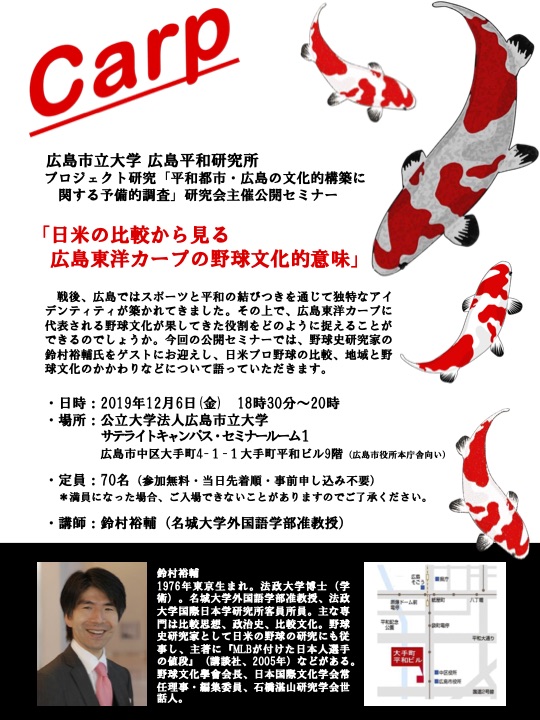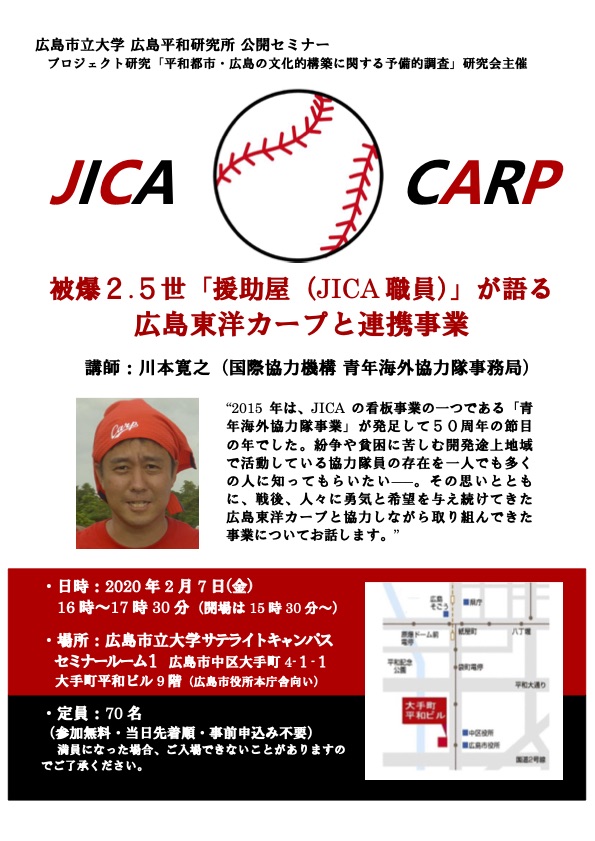河 炅珍(准教授)
背景--スポーツと平和
平和とスポーツの結びつきは、長い歴史を持っています。例えば、古代ギリシャで行われたオリュンピア大祭や、中世のイングランドが起源といわれるサッカーの歴史はもちろん、現代では、オリンピック競技大会やFIFAワールドカップなど、メガイベントに見るように、スポーツは、時には「戦争の代用品」として、時には「平和の象徴」として発達してきました。
スポーツは、各種目の選手が競い合う祭典としてだけでなく、膨大な数の観客を動員し、開催国・地域に経済的効果をもたらし、政治・外交の面では平和と繁栄を物語るシンボリックな儀式としても定着しています。それゆえ、スポーツは、価値を創出する文化現象として、行政と民間、両方から注目されてきました。
スポーツと平和の結びつきは、多くの場合、「国家」を担い手として語られる傾向があります。例えば、オリンピックの参加選手はそれぞれ「母国」の代表として参加しますし、試合の成績は国民感情にも影響し、開催国が享受する経済効果も少なくありません。しかし、スポーツと文化の結びつきは、必ずしも「ナショナル」な次元に限定されて現れているわけではありません。
例えば、プロリーグは、全国のファンに支えられ、その拠点となる地域社会とも緊密な関係を形成しています。スポーツ・チームの存在や活動は、自治体行政にとってはもちろん、ローカルビジネスや地域住民のアイデンティティ、生活に対しても貢献し、地域の文化資産となる場合もあります。
目標--広島東洋カープと文化共同体
本研究は、スポーツと平和を考える視点を「ナショナル」から「ローカル」、あるいは「リージョナル」に移しながら、地域社会を基盤とする「文化的共同体」の形成に光を当てています。
戦後、広島では、原爆投下後の廃墟から「国際平和文化都市」の建設を目指し、行政や市民から様々な復興の動きがありました。広島の地から生れた共同体精神は、これまでの広島論・広島研究を通じて、戦争、原爆、被爆、軍縮といった様々なテーマとともに語られてきました。それを踏まえつつ、「スポーツ文化」を新しい切り口に、広島における平和の意味を捉え直してみたい――。この思いから本研究ははじまりました。
現在、広島を拠点に行われているスポーツは、サッカー、バスケットボール、バレーボールなど様々ですが、なかでも「広島東洋カープ」(以下、カープ)に代表される野球文化は、広島・広島人のアイデンティティと非常に深い関係にあると思います。歴史的にみれば、カープの誕生は、平和都市としてスタートを切った戦後広島の誕生/再生と時期的にも重なっています。近年では、「カープ女子」や「カープ応援団」などが話題となり、ファンの熱い応援に支えられたリーグ優勝とその秘訣を探る議論が、スポーツ・ジャーナリズムの世界で活発になっています。
「カープブーム」ともいえるこの現象を、広く平和学の観点から捉えてみたら、何が見えてくるのでしょうか。
カルチュラル・スタディーズを中心に、歴史、メディア、法、行政、平和運動、スポーツ産業、地域研究など、各分野からなる多彩な観点を取り入れながら、本研究では、広島における「平和」のアイデンティティが築かれていく過程でスポーツが担った役割を明らかにすることで、広島における「文化的共同体」のオリジナリティを吟味してみたいと思います。スポーツから「平和都市・広島」の新たな姿を浮かび上がらせることが、本研究の狙いです。
計画--カープと広島の歴史を研究
本研究は、2019年度よりはじまり、2020年度までの2年間を予備的調査期間(プレ研究)とし、広島という歴史的空間を対象に実証的研究に取り組んでいきます。広島東洋カープにかかわる歴史を、球団だけでなく、政治(行政)、経済(地元企業)、市民社会(ファン)の相互的な関係から検討し、様々なアクターによる「広島=カープ」の文化的形成とダイナミズムを究明していきます。具体的には、次の六つの課題が挙げられます。
- 文化史的な観点からみた、広島東洋カープの誕生と発展
- 戦後復興におけるスポーツの意味、とくに「平和」という言葉や概念の変容
- 地方行政との関係:法や政策の側面から復興計画がカープに及ぼした影響
- 地元企業との関係:マツダをはじめとする地元企業、メディアの影響
- 市民社会との関係:「市民球団」の形成における地域住民、ファンの役割
- 広島カープの普遍性/特殊性をめぐる比較:日本国内(甲子園、阪神)や国際(ドイツ、韓国、中国)の事例など
期待される研究成果
学術面では、学際的アプローチを通じて、①広島東洋カープを切り口にした「広島文化論」、②国家が担い手となるナショナルなスポーツに対し、地域社会を基盤とするリージョナル、ローカルな「スポーツ社会論」、③文化的共同体の形成から捉えた戦後広島の「復興論」の三つの分野において、新しい広島論・平和論の可能性を切り開いていくことを期待しています。研究終了後は、研究成果をまとめた報告書などの刊行、関連学会における報告や論文投稿、国内外の研究者を招いたシンポジウムや市民講座の開催を考えています。
活動--市民向けプログラムも充実
研究期間中は、広島平和研究所のメンバーを中心に、個別調査研究、定期研究会(非公開)を行うほか、外部講師を招いた公開セミナー(一般参加可)を開催しています。
その第一回目として、2019年12月に名城大学外国語学部の鈴村裕輔氏を講師に迎え、「日米の比較から見る広島東洋カープの野球文化的意味」というタイトルで公開セミナーを実施しました。また、2020年2月には国際協力機構青年海外協力隊事務局の川本寛之氏を招いて「被爆2.5世「援助屋(JICA 職員)」が語る広島東洋カープと連携事業」についてお話をいただいています。今後も引き続き、公開セミナーを実施しますので、ご関心のある方はぜひご参加ください。なお、将来的には、市民講座やシンポジウムの開催も考えています。
メンバー
- 河炅珍(代表)、広島平和研究所准教授
- 河上暁弘、広島平和研究所准教授
- 徐顕芬、広島平和研究所准教授
- 孫賢鎮、広島平和研究所准教授
- 竹本真希子、広島平和研究所准教授
Preliminary Research of Cultural Construction of “Peace City Hiroshima”: Through the History of Baseball Team “Hiroshima Toyo Carp”
HA, Kyungjin (Associate Professor)
Background
We consider the unique relationship between the local community and sports culture and analyze the historical formation of Hiroshima, which is known as an “International Peace Culture City.” The relationship between peace and sports has a long history. As we see in the cases of ancient Greece and medieval England, sports have developed within human societies to both function as a “substitute of war” as well as a “symbol of peace.”
In modern days, this history continues and even further expands with mega-events like the FIFA World Cup and the Olympic games. There is no doubt that those mega-events are global: they are organized by global capital as well as consumed by a global audience. However, at the same time those events could be explained as expressing a strong sense of nationalism. Nations are the most powerful promoters of global events: with each game as fans cheer players and teams, the audience’s actions embody the value of patriotism.
In this way, nations have been keeping a major position in the history of sports culture, however beside the national, there is another dimension as well. Not only amateur leagues and friendly matches, but also professional leagues are “local” and “regional,” shaping unique cultural relationships based on community. Professional leagues entertain nationwide fans, though each team also has a pronounced connection with their local community and fans at their “home field.” Communities are partners for these teams and share common destinies: each team influences local business, administrative policies, as well as the lifestyle of community members. Sports teams represent local identity and welfare as cultural assets and legacy.
Overview
This project will shed a light on the relationship between Hiroshima’s local community and its famous baseball team and the construction of sports culture as well as peace culture. We are investigating how people are organized in an imagined community through the common experiences and historical background of sports fanship.
Hiroshima has been a key location to discuss the transformation of postwar society as well as reconstruction. The characteristics and spirit of community in Hiroshima has been reviewed regarding important issues like war, the A-bomb and disarmament.
We will also pursue those issues and previous research based historical arguments, at the same time, we intend to go one step further and shed a light on sport culture and discuss a different and critical face of “Peace City Hiroshima.”
Now, in Hiroshima many sports clubs are active: basketball, football, volleyball, hockey and etc. Among those the most famous sports team is the “Hiroshima Toyo Carp” baseball team. The Carp have the strongest fandom and influence on community in Hiroshima. Historically, social circumstances promoted the birth of the Carp concurrent with the era of rebirth for postwar Hiroshima.
In recent years, “Carp Joshi,” which means female Carp fans, and “Carp Cheer Team” have become symbols trending in fan fashion in the baseball world. Many sport journalists have paid immense attention to the Carp and its fandom, assessing these as critical factors in the team’s recent league victories. On the other hand, in spite of the symbolic meaning of Carp, few scholarly inquiries have sought to reveal the social and cultural relationship between the Carp/sport and Hiroshima/community.
Our goal is to reveal those relationships and suggest a new perspective for understanding “Peace” culture in Hiroshima in relationship to the unique identity of Hiroshima. For that, we examine the history of the team, but also focus on dynamic interactions among various stakeholders like administration, business and civil society.
Plans and RQs
Our project is based on an interdisciplinary approach, including cultural studies, history, administration, law, international relations, peace movements, sports industry, and local business. We also pursue a comparative analysis with similar cases in Korea and China. Below are major questions of our research.
- The cultural history of Carp.
- Correlation between the peace movement and the Carp. In other word, possibilities of links between concepts of peace and the development of sports in Hiroshima.
- Local administration and its role in the cultivation of Carp and sports culture, especially focusing on the aspects of reconstruction plans.
- Function of local businesses, including Matsuda and local media.
- Function of civil society and fans in the creation of the myths of “Civic Team” and “Civic Stadium.”
- Comparative analysis: other pro teams in domestic leagues like the Hanshin Tigers, as well as in abroad (Lotte Giants, Korea).
Academically, we will provide a new perspectives that could contribute to the following three topics: (1) Cultural background of sports culture in Hiroshima in the case of Carp, (2) Studies of local community which focus on the aspect of sport business, (3) Arguments of community theory based on the reconstruction in postwar Hiroshima.
Research outcomes will be published in reports, journal articles as well as an HPI hosted symposium and public lecture series upon completion. Also, public seminars will be organized as the project progresses.
Members
- HA, Kyung Jin (project leader): Associate Professor, HPI
- KAWAKAMI, Akihiro: Associate Professor, HPI
- SON, Hyun Jin: Associate Professor, HPI
- TAKEMOTO, Makiko: Associate Professor, HPI
- XU, Xianfen: Associate Professor, HPI


